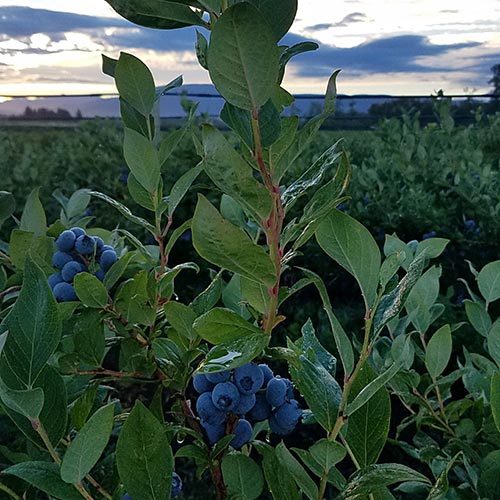
Highbush blueberry (Vaccinium corymbosum) is a woody perennial shrub that is a member of the heath, or Ericaceae, family. One unique feature of plants within this botanical family is that they require acidic soil conditions with pH ranges between 4 to 5 units. Other members in this plant family include lowblush blueberry, cranberry, huckleberry, rhododendrons, azalea, and heather.These shallow-rooted crops require specific conditions for successful production. Please review the information below to learn more about successful production of blueberry.
NEW
- Protecting Wild Bee Crop Pollination Services: Commercial Bumble Bee Best Management Practices (January 2024; pdf)
- Harvesting Blueberries: A Guide to Machine Pick Blueberries for Fresh Market (DeVetter et al., 2021)
Production Overview – Economics
- 2015 Cost Estimates of Establishing and Producing Organic Highbush Blueberries in Eastern Washington (Galinato et al., 2016)
- 2015 Cost Estimates of Establishing and Producing Conventional Highbush Blueberries in Western Washington (Galinato et al., 2016)
Site Preparation & Establishment
- Acidifying Soil for Crop Production West of the Cascade Mountains (EM 8857-E , 2004) (pdf)
Review of techniques to lower soil pH. - Acidifying Soil for Crop Production: Inland Pacific Northwest (PNW 599-E, 2007) (pdf) Review of techniques to lower soil pH.
Cultivars
Plant Maintenance
- Blueberry Growth Stages Table (Michigan State University Extension)
- Blueberry Management Schedule (British Columbia AgriFoodBC, last updated in 2012)
General guideline for plant and pest management. - Pollination in High Tunnels (Washington State University)
- Revised Leaf Sufficiency Standards (Oregon State University, 2021)
- Nutrient Management for Blueberries in Oregon (Oregon State University, 2006) Review of nutrient management, including soil and tissue testing.
- Post-Harvest Soil Nitrate Testing for Manured Cropping Systems West of the Cascades (Sullivan and Cogger, 2003)